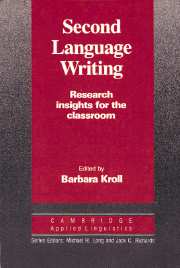Book contents
- Frontmatter
- Contents
- List of contributors
- Series editors' preface
- Preface
- Introduction
- I PHILOSOPHICAL UNDERPINNINGS OF SECOND LANGUAGE WRITING INSTRUCTION
- Chapter 1 Second language composition instruction: developments, issues, and directions in ESL
- Chapter 2 L1 composition theories: implications for developing theories of L2 composition
- Chapter 3 An overview of second language writing process research
- Chapter 4 Coaching from the margins: issues in written response
- Chapter 5 Second language writing: assessment issues
- Chapter 6 Reading–writing connections: toward a description for second language learners
- II CONSIDERATIONS FOR WRITING INSTRUCTION
- Index
Chapter 6 - Reading–writing connections: toward a description for second language learners
Published online by Cambridge University Press: 05 October 2012
- Frontmatter
- Contents
- List of contributors
- Series editors' preface
- Preface
- Introduction
- I PHILOSOPHICAL UNDERPINNINGS OF SECOND LANGUAGE WRITING INSTRUCTION
- Chapter 1 Second language composition instruction: developments, issues, and directions in ESL
- Chapter 2 L1 composition theories: implications for developing theories of L2 composition
- Chapter 3 An overview of second language writing process research
- Chapter 4 Coaching from the margins: issues in written response
- Chapter 5 Second language writing: assessment issues
- Chapter 6 Reading–writing connections: toward a description for second language learners
- II CONSIDERATIONS FOR WRITING INSTRUCTION
- Index
Summary
Decisions about English as a second language (ESL) writing class activities are aimed at providing a language environment in which the ESL writer can begin to construct text that is clearly recognizable as written English. Teachers wrestle with the usefulness of classroom work focusing on, for example, transition words, sentence structure, paragraph development, or rhetorical patterns. It is understandable, then, that many of the questions that shape ESL writing classroom practices center on the issue of what constitutes the relevant language input from which second language learners construct their hypotheses about second language (L2) written text. Traditionally the answer has been reading.
Reading in the writing classroom is understood as the appropriate input for acquisition of writing skills because it is generally assumed that reading passages will somehow function as primary models from which writing skills can be learned, or at least inferred. The nature of this reading–writing link, though not well-defined, is often thought to be like Krashen's notions about second language acquisition. In fact, Krashen (1984) claims that the development of writing ability and of second language proficiency occur in the same way: via comprehensible input with a low affective filter. He theorizes that writing competence derives from large amounts of self-motivated reading for interest and/or pleasure. “It is reading that gives the writer the ‘feel’ for the look and texture of reader-based prose” (p. 20).
- Type
- Chapter
- Information
- Second Language Writing (Cambridge Applied Linguistics)Research Insights for the Classroom, pp. 88 - 102Publisher: Cambridge University PressPrint publication year: 1990
- 16
- Cited by



